This post may contain affiliate links. Please read our disclosure policy.
With just a couple of pantry-friendly ingredients, you can make your own delicious homemade oat milk with creamy, rich results every time.
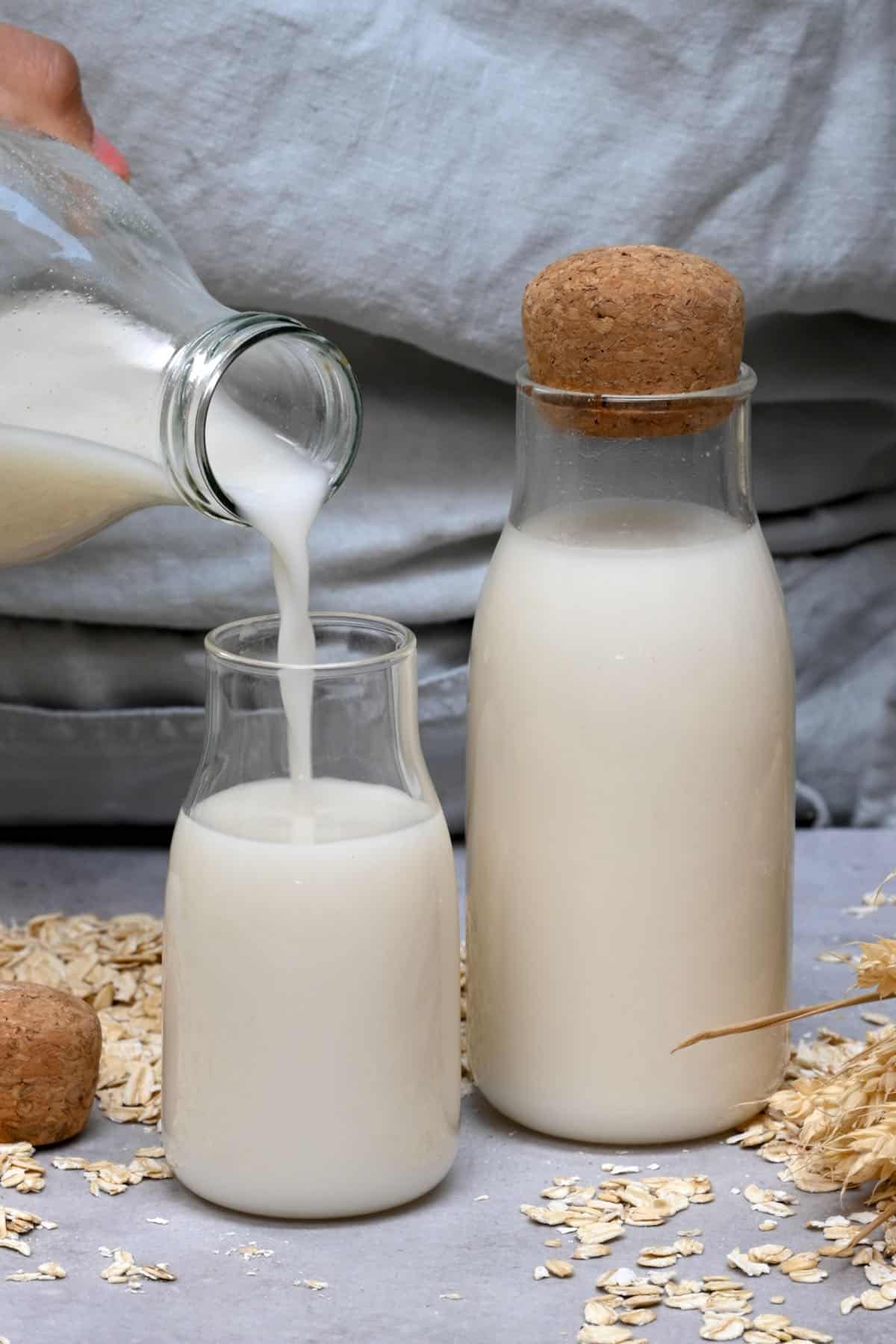
Making oat milk isn’t as daunting as it might sound it’s surprisingly easy! Being one of the most popular dairy-free milk varieties, my DIY oat milk gets a little sweetness from maple syrup and vanilla extract and makes a perfect substitution for dairy milk in baking, for breakfast, or even just in your cup of coffee.
I’ve spent a long time perfecting my oat milk recipe so it doesn’t turn out slimy, has a deliciously creamy taste, and is quick and easy to make.
Want to save this recipe?
Oat Milk Ingredients
- Rolled Oats: I prefer to use organic oats, but you can use any you have to hand, including steel-cut oats and certified gluten-free oats.
- Cold Water: It should be ice cold.
- Salt: Just a pinch of salt will bring out the sweetness in the milk.
- Maple Syrup (Optional): I like to add this as a sweetener, though you can substitute it with honey (either ordinary or vegan) or agave nectar.
- Vanilla Extract (Optional): I also use this for flavor, though you can adjust the amounts based on your taste.
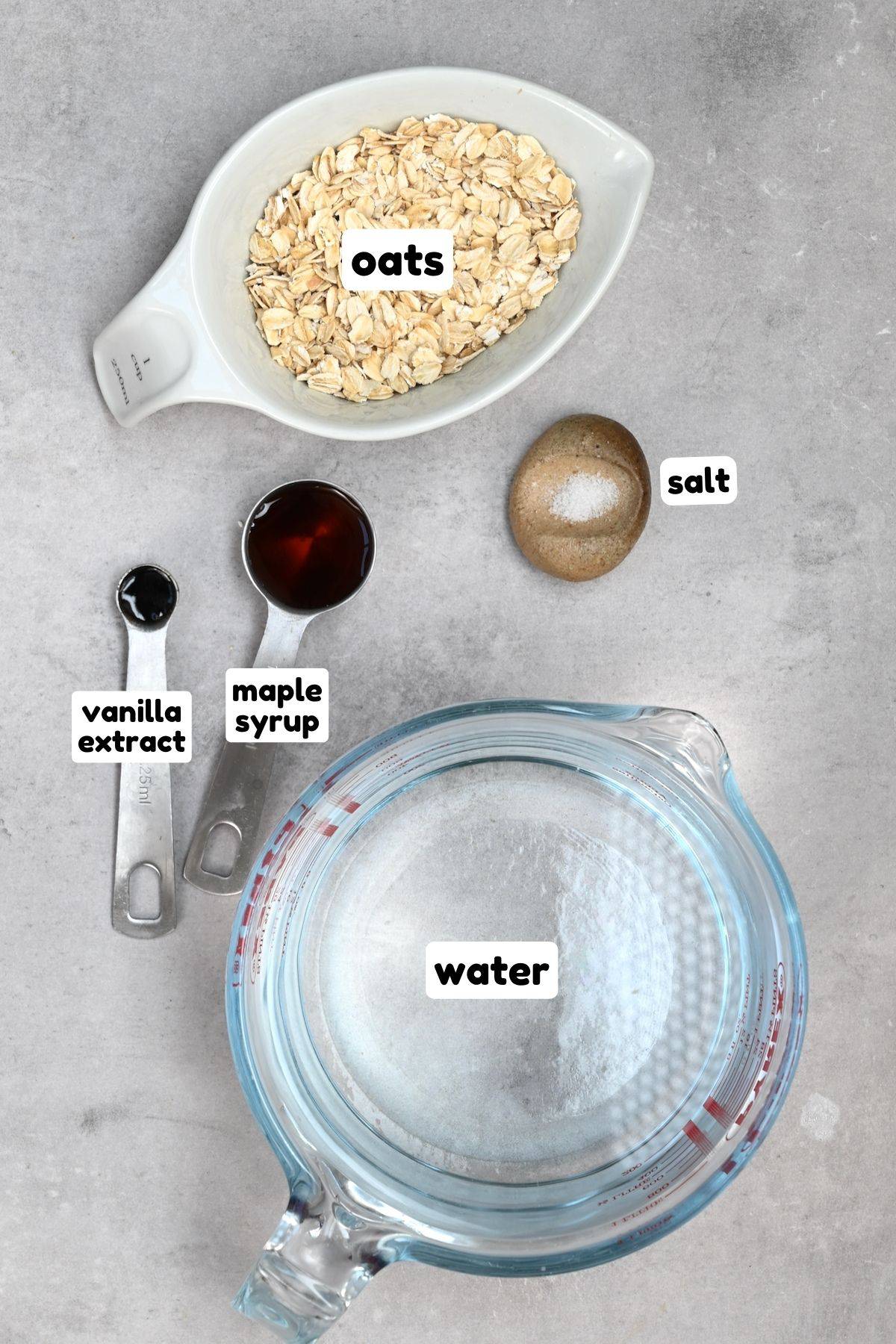
Flavored oat milk
You can flavor your oat milk – just add your desired flavoring either when blending or when ready to drink. These are some of my favorite options:
- Vanilla
- Maple Syrup – or your favorite sweetener. Medjool dates can also work great here if you prefer.
- Cocoa – cocoa powder will make a delicious chocolate oat milk – great for kids!
- Strawberry or your favorite berries.
- Coffee.
How to make oat milk
Add your rolled oats, water, salt, vanilla extract, and maple syrup (if using) to a high-speed blender and blend for 10 seconds (15-20 seconds if you’re not using a high-speed blender).
Once the oats have been fully blended, pour the mixture into a nut milk bag or a fine mesh strainer lined with a few layers of cheesecloth. I recommend having the bag in a bowl already before you pour the oat mix in.
Using your hands, strain the milk through. You should have a thin liquid with no lumps or extra mix in it and the pulp still in the bag. For super-smooth milk, strain the oat milk twice.
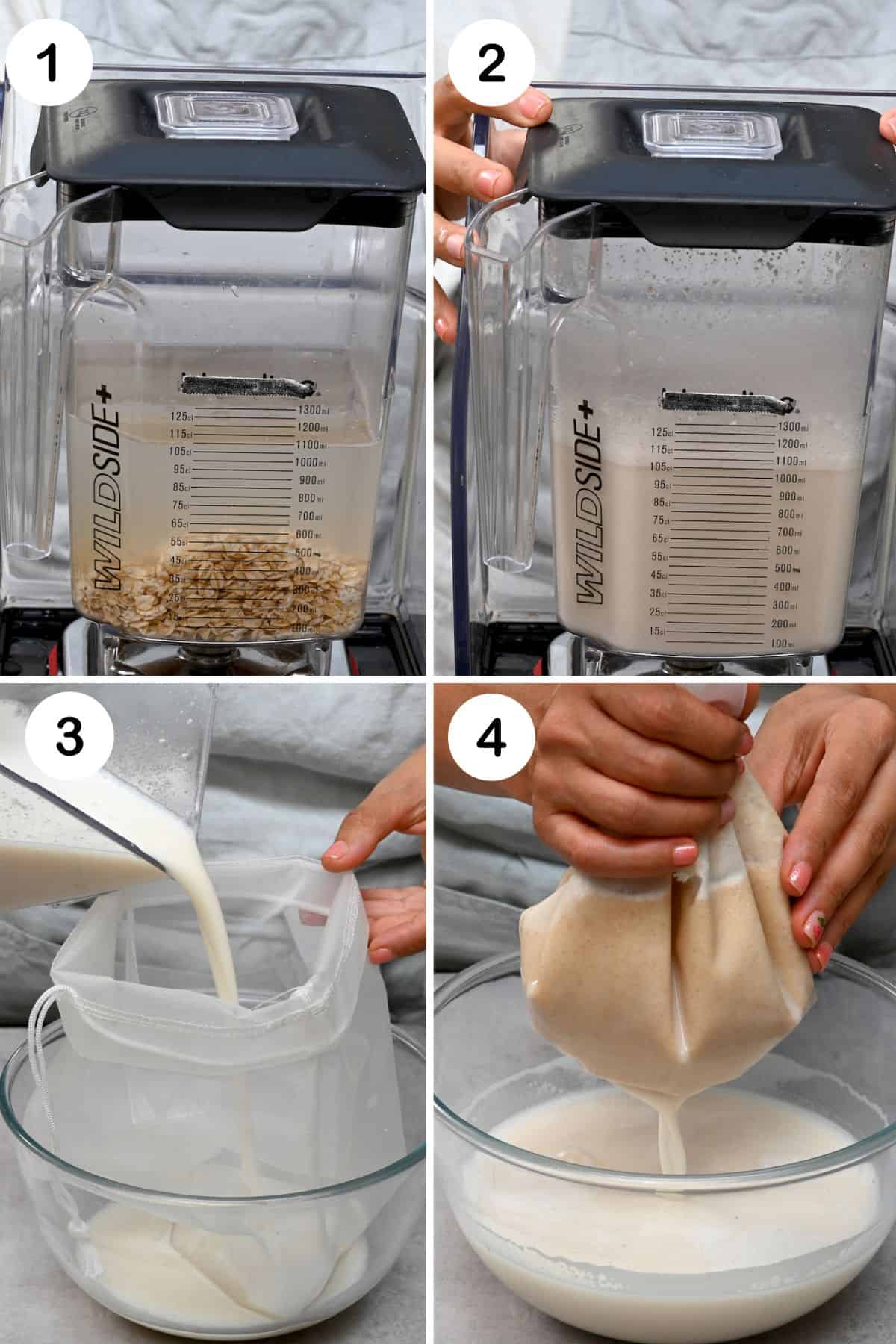
Top tips to avoid slimy oat milk
If you want to make your own oat milk – you don’t want a slimy result! These are my top tips for getting perfect oat milk every time:
- Use Dry Oats: Your oats should be completely dry when you add them to the blender. If they’re wet, they won’t soak up as much of the liquid and will give the milk an unpleasant texture.
- Don’t Over Blend: High-speed blenders work quickly, so you don’t need more than 10 seconds to get the right texture. Over-blending causes heat and friction, which changes the overall composition of the oat milk – making it slimy.
- Don’t Over-Squeeze: The trick when straining is to handle the oat milk as little as possible. Too much squeezing causes more of the starch compounds from the oats to end up in your milk, which results in a slimy thick texture.
- Double-Straining: Straining the oat milk mix twice in the bag will remove any extra pulp and starch that could make the milk slimy.

How to use oat milk
- Use as an alternative to creamer or milk in coffee – try it in a matcha green latte or TikTok favorite, a Dalgona latte.
- Substitute in vegan baking and add to my favorite chocolate chip cookies or my healthier chocolate digestives.
- Use for breakfast favorites – this milk is great for chia seed pudding, overnight oats, and smoothie bowls.
What to do with the leftover oat pulp
The leftover pulp can also be used in a variety of ways – and it’s easy to make this recipe completely no waste. Use the pulp for:
- Breakfast dishes, especially overnight oats, muesli, oatmeal, and chia seed pudding.
- Use in baking for extra fiber – it works great for cookies, brownies, and muffins.
- Add to smoothies for fiber and protein.
- Use around the house – you can use it to make face masks, body masks, and compost.
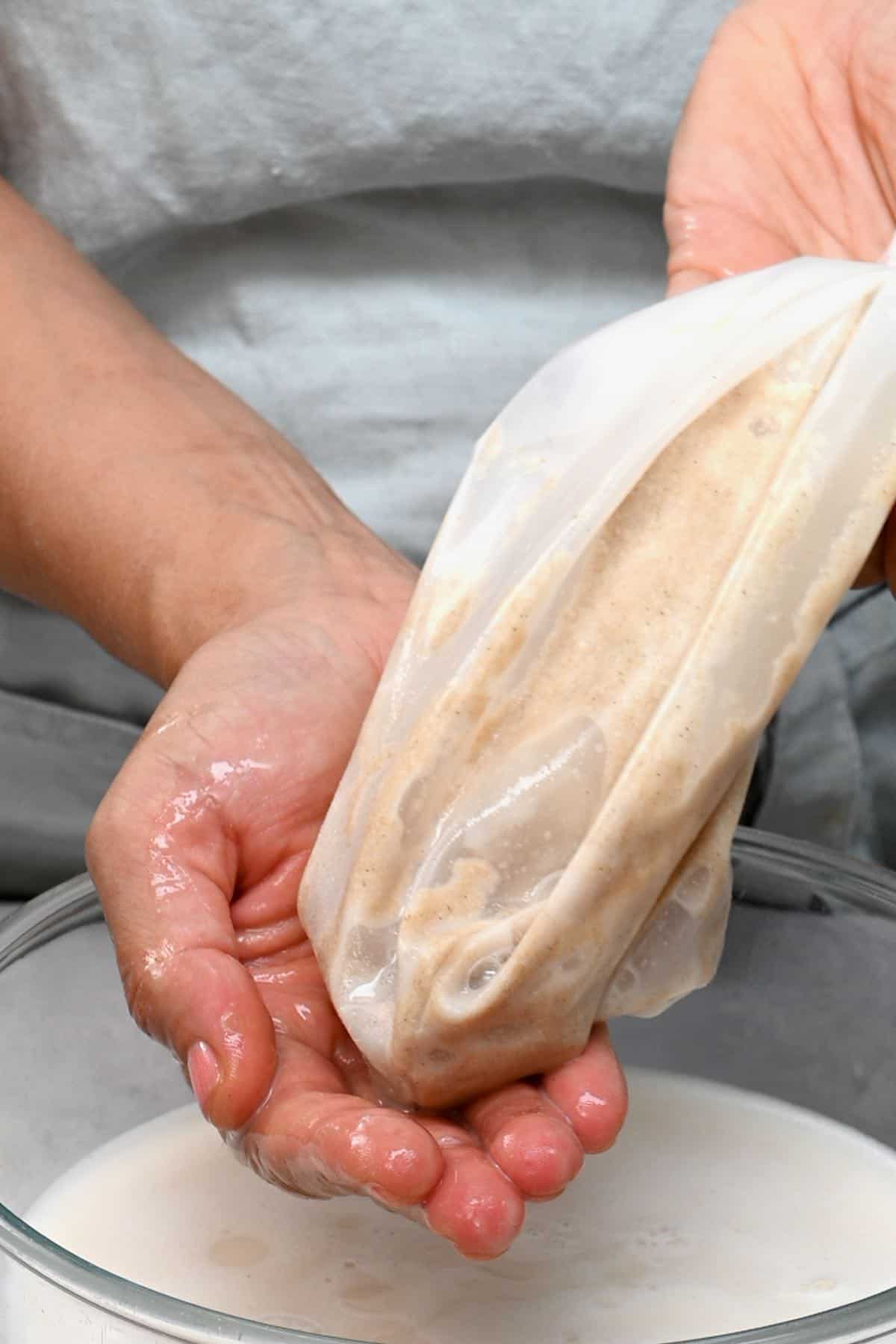
Can you heat oat milk?
Yes – but it’s best to do it slowly. Heat it gently over low to medium heat and stir it until it’s reached your desired temperature. Just be careful to not overheat, as it can thicken and get a strange taste if it’s heated too fast.
How long does homemade oat milk last
Once it is ready, transfer it into pre-sterilized containers or glass jars. Stored in the refrigerator, the homemade milk should be kept for up to 4-5 days. If you decide to use extra flavorings in your oat milk, this can affect the shelf life, so keep an eye on it after a few days.
More homemade plant-based milk recipes
If you try this oat milk recipe, let me know how it goes in the comments below. I’d appreciate a recipe card rating and would love to see your recipe recreations – tag me on Instagram @Alphafoodie!
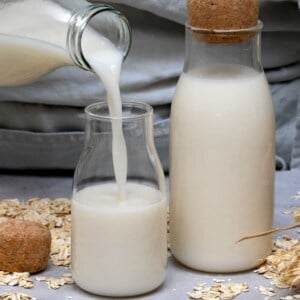
How To Make Oat Milk
Equipment
Ingredients
- 3/4 cup rolled oats use organic and/or gluten-free if needed
- 4 cups water ice cold
- 1/8 tsp salt
- 1 Tbsp maple syrup optional, or sweetener of choice
- 1/4 tsp vanilla extract optional
Instructions
- Add all the ingredients into a high-speed blender and blend for 10 seconds (15-20 seconds if you're not using a high-speed blender).
- Pour the mixture through a nut milk bag or a fine-mesh strainer lined with several layers of cheesecloth (don't over squeeze!).Optional: Strain twice for super-smooth milk.
- Enjoy immediately or transfer to a sterilized bottle.
How To Store
- Fridge: Once bottled, store it in the fridge for 4-5 days, shaking it well between each use. When it's bad, it will start to smell and taste sour/off.Freezer: It will freeze for up to 3 months. However, upon thawing, it may be a little gritty and require re-blending for a few seconds and/or re-straining.
Video
Notes
- Use Dry Oats: Your oats should be completely dry when you add them to the blender. If they’re wet, they won’t soak up as much of the liquid and will give the milk an unpleasant texture.
- Don’t Over Blend: High-speed blenders work quickly, so you don’t need more than 10 seconds to get the right texture. Over-blending causes heat and friction, which changes the overall composition of the oat milk – making it slimy.
- Don’t Over-Squeeze: The trick when straining is to handle the oat milk as little as possible. Too much squeezing causes more of the starch compounds from the oats to end up in your milk, which results in a slimy thick texture.
- Double-Straining: Straining the oat mix twice in the bag will remove any extra pulp and starch that could make the milk slimy.
- Flavor Options: Add your desired flavoring when blending or when ready to drink. Here are some of my favorite options:
- Vanilla
- Maple Syrup or your favorite sweetener. Medjool dates can also work great here if you prefer.
- Cocoa to make chocolate milk.
- Strawberries or other berries.
Nutrition
Nutrition information is automatically calculated, so should only be used as an approximation.

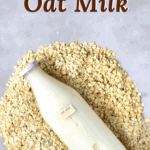
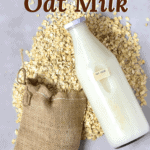


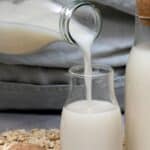
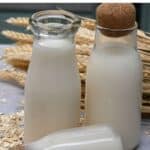









Hi there, do you notice that the oat milk gets slimy by the 4-5 day mark? Or does it stay “non-slimy” the entire time??
Thanks!
Hi Amira,
The shelf life of the oat milk is 4-5 days. During that period it should stay non-slimy but it’s possible that it separates (it’s natural) and you’d only need to shake it before you use it.
I hope this helps.
Is there anything I can use the pulp for? Also, have you ever tried combining it with rice milk?
Hi Maggie,
You can use the leftover pulp in smoothies or breakfast bowls, or in overnight oats. You can use it for homemade granola/breakfast topping. Alternately, you can also let the leftover pulp dry out and grind it into flour to add to baked or no-bake goodies.
So far, I haven’t combined oat milk with rice milk. Let me know if you give it a try.
I noticed when making the oat milk, you didn’t use a nut bag to strain the oat milk. Also, would you be able to tell me the name of your blender. Thanks
Hi Lee,
The NutraMilk blender I use has a special straining system so you can skip the nut bag straining step.
If you use a regular blender or food processor, then you need to use a nut milk or cheese cloth bag to collect the pulp. 🙂
I hope this helps.
I really like the easy navigation of your site~hearts from me on that note. I wanted to let you know that there is a much easier way to make your oat milk less slimy and that is by adding a couple capsules of food enzymes. Amylase is the enzyme that will break down the starch(which is an obvious contributor to slime). If you’re willing to spend a bit of extra money–buy a broad spectrum digestive enzyme and add it in. Best wishes!!
thank you for the tip! I haven’t heard of that before. I’ll have to give it a try at some point 🙂
Hi shaney
When do you add the probiotic?
Thank you for sharing this recipe. It is the best for oat milk I’ve tried so far and I don’t think I will try anymore, I’ll just stick to this one. The ratios are perfect! I just leave the cashews out and add a a little bit of vanilla essence. Perfect!
I’m so glad to hear that you like it! It took me quite a few experiments to get it just right – but I’m so happy to now have this go-to for Oat milk. Vanilla sounds absolutely delicious with it!
Can we replace the cashews with walnuts or almonds? Thanks!
unfortunately, I don’t think other nuts would work in the same way. While you can include them for additional flavor combinations, cashews are a great nut for adding extra creaminess.
That is actually not correct, walnuts are routinely used by commercial plant based milk producers as it is actually creamier than cashews once finely blended. However they must be soaked for at least 24 hours in distilled water preferably or for 4 hours in resting boiled water.
Thank you for the information! I’d honestly never thought to use walnuts because of the stronger flavor they have in comparison to cashew. I’ll take that advice on board! 🙂
Hi,
If I’m allergic to nuts, is there something else that I could add to make the oat milk creamy? Coconut oil?
Thank you
Hi Marilyn, yes that’s correct, you can simply add some oil like I did in the oat coffee creamer. If you read that blog post, it will provide a lot of tips 🙂
Can you use quick steel cut oats in this recipe?
Yes. The texture may differ slightly but it should still work 🙂
Should I be able to use a fine mesh strainer like a powdered sugar sieve instead of the nut bag if I use the soaked cashews with the oats?
cashews can/ will become very fine material once broken down in the blender so I can’t guarantee that a mesh strainer will catch all of the pulp. However, if you give it a try then let me know 🙂
If you’re using the NutriMilk appliance, which filters the milk as it dispenses, do you still have to use a nutmilk bag?
No- when using the Nutramilk I usually omit the nut milk bag step altogether 🙂